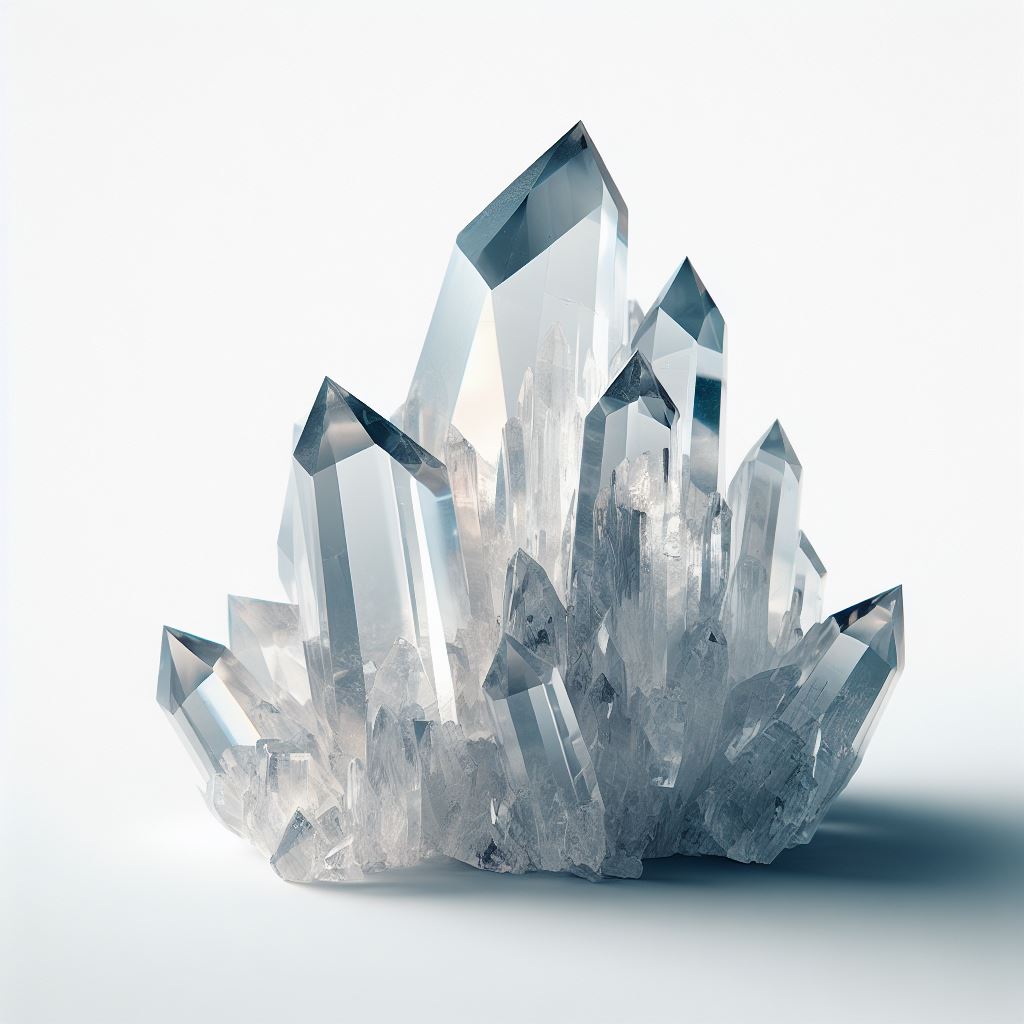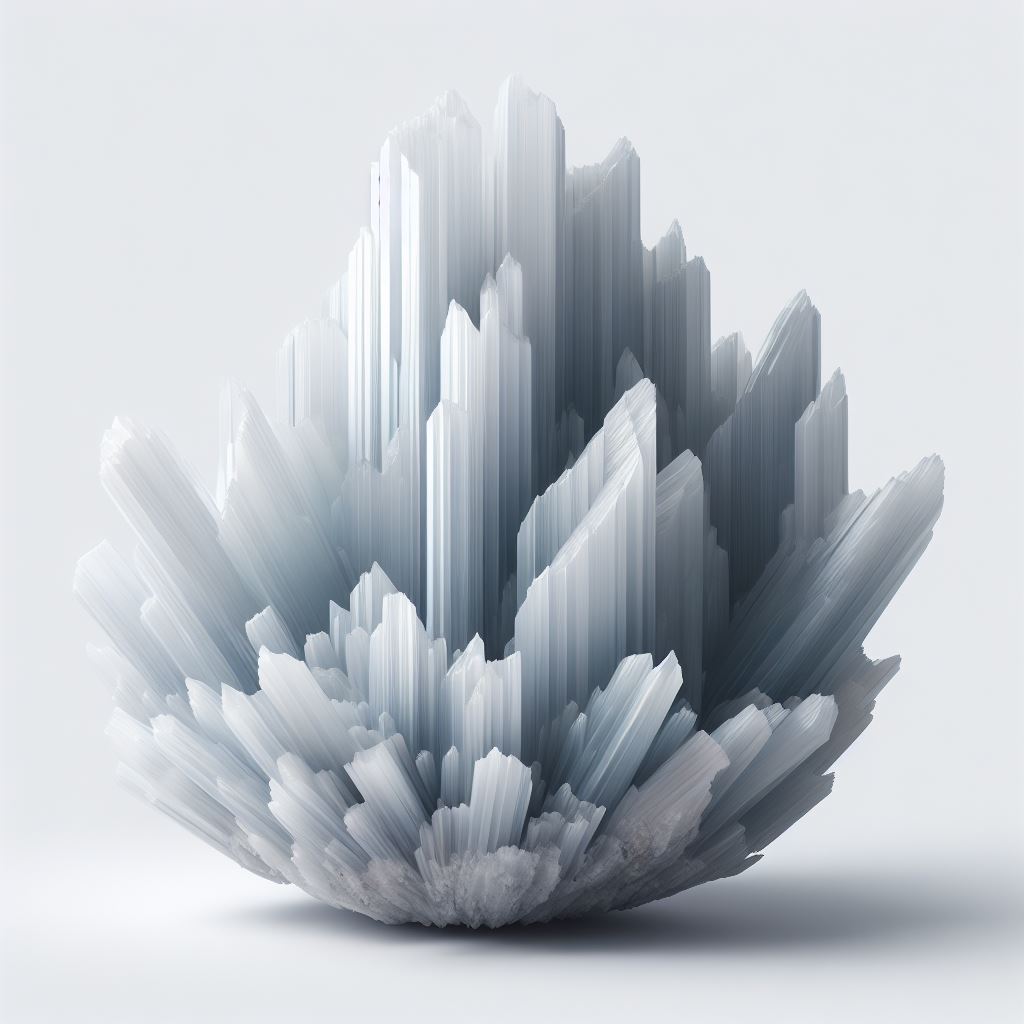Hematite, one of the most abundant minerals on Earth, is a reddish-brown iron oxide with a captivating metallic luster. It has played a significant role in human history, particularly during the Iron Age, due to its association with iron deposits. This versatile mineral, metallic hematite, has found its place in various domains, from adornments to healing practices. It is abundant in iron deposits and comes in two forms: gray hematite and metallic hematite. Its significance stems not only from its aesthetic appeal but also from its unique magnetic properties. Metallic hematite, also known as specular hematite, is a common mineral material that possesses these distinct qualities.
Hematite, a common mineral containing iron oxide, has been widely used by societies for centuries. Its distinctive color and shine have made it a popular choice for jewelry-making. Metallic hematite, an iron oxide, has served as a pigment for creating vibrant red hues and even as a healing stone believed to possess grounding and balancing qualities. Its reddish streak makes it a sought-after rock.
The name “hematite” originates from the Greek word “haima,” meaning blood, owing to the reddish streak of iron oxide that results when hematite, a mineral, is ground into a fine powder. Hematite is a red mineral rock that consists mainly of iron oxide. It is known for its iron atoms bonded with oxygen atoms, making it a valuable specimen. These chemical properties of metallic hematite, an iron oxide rock, give rise to its remarkable magnetic behavior and color.
With an exploration into the history and properties of hematite, this blog post delves deeper into the allure and significance of this red rock throughout time. Hematite is a form of iron oxide that has a distinct streak when scratched against a surface.
Significance of Hematite in Mineralogy and Crystal Healing
Hematite, a red rock, holds immense significance in the fields of mineralogy and crystal healing. Its streak and unique form make it a highly sought-after mineral. Let’s delve into the importance of the red streak and the benefits that metallic hematite offers.
Valued for its Iron Content
One of the primary reasons hematite is highly valued in mineralogy is because of its iron content, which gives it a distinctive red streak. It is a red iron oxide mineral, consisting mainly of iron atoms bonded with oxygen atoms. The mineral often exhibits a streak of red color. This composition gives hematite its characteristic reddish-brown or silver-gray coloration, making it a streak. Its rich red iron content makes it a valuable resource for various industrial applications, including the production of pigments, jewelry, and even as an important ore for extracting iron metal. The red streak of this mineral is highly sought after in the production of pigments and adds value to its use in jewelry making. Additionally, its high iron content makes it a significant ore for extracting iron metal.
Grounding and Protective Properties
In crystal healing practices, hematite, with its red color and streak, is believed to possess grounding and protective properties. It is often used to create a sense of stability and balance within oneself, especially when trying to maintain a streak. By connecting with the earth’s energy, hematite can help individuals feel more grounded and centered in their daily lives.
Emotional Balance and Focus Enhancement
Another benefit associated with hematite in crystal healing is its ability to balance emotions. It is believed to have a calming effect on one’s emotional state by promoting feelings of peace and tranquility. Hematite can assist individuals in managing stress, anxiety, and overwhelming emotions.
Moreover, hematite is said to enhance focus and concentration. By wearing or carrying hematite crystals, individuals may experience improved mental clarity, allowing them to stay focused on tasks at hand or during moments that require deep concentration.
Tackling Negative Energy
Many people use hematite as a talisman against negative energy. It is believed that this stone has the power to absorb negative energies from the environment or from other people. Hematite acts as a shield that deflects negativity away from the wearer or user.
By wearing hematite jewelry or keeping it close by, individuals may find themselves feeling more protected from external influences that could potentially drain their energy or affect their well-being.
Geological Importance and Occurrence of Hematite
Hematite, a common mineral found in sedimentary rocks around the world, plays a significant role in geology and the formation of iron ore deposits. It forms through the precipitation of iron-rich minerals in water bodies, creating distinct reddish-brown or blackish crystals. Let’s delve into the geological importance and occurrence of hematite.
Found in Sedimentary Rocks
Hematite is abundant in sedimentary rocks due to its formation process. As water bodies evaporate or undergo chemical changes, iron-rich minerals like hematite precipitate out and settle in layers over time. These sedimentary rocks can be found across various regions globally, making hematite a widely distributed mineral.
Indication of Water Activity
The presence of hematite can indicate past or present water activity on Mars. Scientists have discovered large deposits of hematite on Mars’ surface, suggesting that liquid water may have once existed there. This finding is crucial in understanding the planet’s geological history and its potential for supporting life.
Major Deposits Around the World
Some countries boast significant deposits of hematite, making it an important ore for iron production. Brazil, Australia, and China are known for their extensive reserves of this mineral:
- Brazil: The Quadrilátero Ferrífero region in Brazil contains vast hematite deposits. These deposits contribute significantly to Brazil’s status as one of the world’s leading iron ore producers.
- Australia: The Pilbara region in Western Australia is renowned for its massive iron ore deposits, including substantial amounts of hematite. Australia’s mining industry heavily relies on these resources.
- China: China also has substantial hematite reserves, particularly in regions such as Liaoning Province and Hebei Province. The country utilizes these deposits to support its growing steel industry.
Formation with Goethite
Hematite often forms alongside another iron oxide mineral called goethite. These minerals have similar chemical compositions and often occur together in sedimentary rocks. The presence of goethite alongside hematite can provide valuable insights into the geological processes that took place during their formation.
Hematite’s Role in Early Civilization and Cultural Beliefs
Hematite, a striking mineral known for its deep red color, played a significant role in the history of early civilizations. Ancient cultures recognized its unique properties and utilized it for various purposes. Let’s explore how hematite was valued by these societies and the cultural beliefs associated with it.
Ancient civilizations used hematite for decorative purposes, such as making beads or amulets.
In ancient times, people discovered that hematite could be shaped into beautiful ornaments. They crafted beads, pendants, and amulets from this lustrous mineral. These decorative items were highly prized and often worn as symbols of status or religious significance. The smooth texture and vibrant red hue of hematite made it an appealing choice for personal adornment.
Some cultures believed that hematite had protective powers against evil spirits or illness.
Many ancient civilizations attributed supernatural qualities to hematite. They believed that wearing jewelry made from this mineral would provide protection against evil spirits or ward off illness. This belief stemmed from the idea that hematite possessed inherent spiritual energy capable of repelling negative forces. These cultural beliefs highlight the reverence placed on hematite as a talismanic material.
In ancient Egypt, hematite was associated with blood and considered a symbol of life force.
The ancient Egyptians held hematite in high regard due to its resemblance to blood. They associated this mineral with vitality and considered it a symbol of life force. Hematite was often used in funerary rituals to ensure the deceased had eternal life in the afterworld. Its connection to blood also led to its association with healing practices in Egyptian medicine.
The Mesopotamians used hematite for seals, signifying authority or ownership.
The Mesopotamians recognized the durability and distinctive appearance of hematite, which made it ideal for creating seals. These seals were engraved with intricate designs and used as a mark of authority or ownership. By impressing the hematite seal onto clay tablets, individuals could authenticate documents and establish their identity. This application of hematite showcases its practical use in ancient administrative systems.
The historical significance of hematite extends beyond its functional applications. Its presence in cave paintings provides evidence of early human creativity and artistic expression. For example, the Lascaux caves in France contain paintings dating back thousands of years, where hematite was used as a pigment to create vivid red hues.
In Babylonian culture, hematite was believed to possess magical properties that could influence the gods and bring good fortune. The Babylonians incorporated this mineral into various rituals and ceremonies, seeking protection and prosperity.
The Meaning and Symbolism of Hematite in Folklore
Hematite Symbolizes Strength, Courage, and Protection in Folklore from Various Cultures
Hematite has long been regarded as a powerful symbol in folklore across different cultures. It is associated with qualities such as strength, courage, and protection. People believed that wearing or carrying hematite could help them tap into these attributes and enhance their own.
In ancient times, hematite was highly valued for its protective properties. Many believed that it had the ability to ward off negative energies and evil spirits. It was often worn as an amulet or talisman to provide a sense of security and safeguard against harm.
In Native American Traditions, Hematite Was Believed to Bring Balance and Grounding
Native American traditions also hold deep reverence for hematite. They believed that this stone possessed the power to bring balance and grounding to individuals. Hematite was seen as a connection to the Earth’s energy, helping people stay rooted in their surroundings.
The Native Americans recognized the importance of maintaining harmony within oneself and with nature. They believed that hematite could aid in achieving this balance by aligning one’s physical, emotional, and spiritual aspects. By wearing hematite jewelry or keeping it close by, they sought to foster a sense of stability and connection with the natural world.
In Greek Mythology, Hematite Was Associated with Ares, the God of War
Greek mythology offers another perspective on the symbolism of hematite. In ancient Greece, hematite was closely linked with Ares, the god of war. This association stems from its deep red color resembling bloodshed on the battlefield.
Hematite’s connection to Ares represented not only physical strength but also mental fortitude and resilience in times of conflict or adversity. Warriors would wear hematite as armor or carry it into battle believing that it would provide them with protection from harm and grant them the courage to overcome their enemies.
Hematite Was Thought to Have Healing Powers and Was Used to Stop Bleeding in Ancient Times
Beyond its symbolic significance, hematite was also believed to possess healing properties. In ancient times, it was used as a remedy for various ailments, particularly those related to blood disorders. Hematite was thought to have the power to stop bleeding and promote clotting.
Ancient healers would apply hematite directly onto wounds or create poultices using powdered hematite mixed with other substances. They believed that this stone had an innate ability to stimulate the body’s natural healing processes and accelerate recovery.
Hematite as an Iron Ore: Historical Uses and Economic Impact
Hematite, a type of iron ore, has been a primary source of iron for centuries. Its significance in the development of early metallurgy and iron production cannot be overstated. The extraction and processing of hematite have had profound economic impacts worldwide, making it a crucial commodity in various industries.
Hematite as a Major Source of Iron Ore
Hematite is one of the most abundant minerals on Earth and has been mined for thousands of years due to its high iron content. It is found in various forms, including specular hematite, red ochre, and kidney ore. These different varieties have played vital roles in different historical periods.
Role in Early Metallurgy and Iron Production
The history of hematite is closely intertwined with the development of early metallurgy and iron production. Ancient civilizations recognized its potential as a source of iron, which led to advancements in metalworking techniques. Hematite was used to create tools, weapons, and other essential items that shaped human civilization.
Economic Impacts Worldwide
The extraction and processing of hematite have had significant economic impacts globally. Mining operations have provided employment opportunities for countless individuals throughout history. The trade of hematite as an iron ore has fueled economic growth by facilitating the production of various goods.
Importance in the Steel Industry Today
Even today, hematite continues to be an important commodity in the steel industry. Due to its high iron content and favorable physical properties when heated, it is widely used as an ingredient in steelmaking processes. Hematite provides strength and durability to steel products used in construction, manufacturing, transportation, and many other sectors.
Exploring Hematite’s Crystal Healing Properties and Benefits
Hematite crystals have a rich history and are believed to possess numerous healing properties. Let’s delve into the fascinating world of hematite and explore its benefits.
Promotes courage, strength, and vitality
Hematite is thought to be a powerful crystal that promotes courage, strength, and vitality. It is often used by individuals seeking an extra boost of confidence or those looking to overcome challenges in their lives. By working with hematite, people believe they can tap into their inner strength and find the courage to face difficult situations head-on.
Stimulates focus, concentration, and memory
If you’re struggling with focus, concentration, or memory issues, hematite might be just what you need. This crystal is said to stimulate mental clarity and enhance cognitive function. Many people use hematite as a tool for improving their ability to concentrate on tasks at hand or retain information more effectively.
Grounds energy and provides protection
One of the key uses of hematite crystals is grounding energy. When we feel scattered or overwhelmed by our surroundings, hematite can help bring us back down to earth. It acts as an anchor for our energy, allowing us to feel more centered and balanced.
Hematite is believed to provide protection against negative influences. It forms a shield around the wearer or user, deflecting any harmful energies that may come their way. This makes it a popular choice for those who want some extra protection in their daily lives.
Supports the circulatory system and enhances overall well-being
Hematite is not only beneficial for our emotional well-being but also for our physical health. It is thought to support the circulatory system by promoting healthy blood flow throughout the body. Some people even believe that wearing hematite jewelry close to the skin can help improve overall vitality and well-being.
In addition to these benefits, hematite crystals have been used for various other purposes throughout history. For example, due to their high iron content, they were used as a pigment in cave paintings thousands of years ago. Hematite is also known for its magnetic properties and has been used in compasses and other navigation tools.
Unveiling the Fascinating History and Power of Hematite
In this comprehensive exploration of hematite, we have delved into its significance in mineralogy and crystal healing, its geological importance and occurrence, as well as its role in early civilizations and cultural beliefs. We have also uncovered the meaning and symbolism of hematite in folklore, its historical uses as an iron ore, and the economic impact it has had throughout history. Furthermore, we have explored hematite’s crystal healing properties and benefits.
Now that you are armed with a wealth of knowledge about hematite, you can appreciate the rich history and power that this mineral possesses. Whether you are intrigued by its cultural symbolism or fascinated by its geological origins, there is no denying the enduring allure of hematite. So why not embark on your own journey to explore this captivating mineral further? Dive deeper into its crystal healing properties or dive into the pages of history to uncover more about hematite’s impact on civilization. The possibilities are endless!
FAQs
Is hematite safe to wear as jewelry?
Hematite is generally considered safe to wear as jewelry for most people. However, some individuals may experience skin irritation or allergic reactions when in direct contact with hematite due to their personal sensitivities. It is advisable to test a small area of skin before wearing hematite jewelry extensively.
Can I cleanse and recharge my hematite crystals?
Yes, you can cleanse and recharge your hematite crystals to maintain their energetic properties. Hematite is known for being self-cleansing; however, if you feel it needs a boost or has absorbed negative energy over time, you can cleanse it using methods such as running water or smudging with sage.
Does wearing hematite improve blood circulation?
While there are claims that wearing hematite can improve blood circulation due to its iron content, scientific evidence supporting this specific benefit is limited. It is important to consult with a healthcare professional for any concerns regarding blood circulation or other health conditions.
Can hematite be used for grounding and protection?
Yes, hematite is often used for grounding and protection in crystal healing practices. It is believed to help stabilize and balance energy, creating a sense of security and shielding against negative influences. However, individual experiences may vary, and it is essential to explore what works best for you personally.
How should I care for my hematite jewelry?
To care for your hematite jewelry, avoid exposing it to harsh chemicals, extreme temperatures, or prolonged sunlight as these factors can potentially damage the stone’s appearance. Gently wipe the jewelry clean with a soft cloth after wearing it to remove any oils or dirt that may have accumulated. Storing your hematite jewelry separately from other pieces can also help prevent scratches or tangling.



